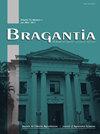Effects of temperature and wetness period on the monocyclic components of persimmon anthracnose
IF 1.5
4区 农林科学
Q2 Agricultural and Biological Sciences
引用次数: 0
Abstract
Anthracnose caused by Colletotrichum horii is one of the most important diseases in the persimmon tree. This study aimed to determine the influence of environmental variables on conidia germination, mycelial growth, and infection in persimmon fruit and shoots/twigs. The germination was quantified at 10, 15, 20, 25, and 30°C, with 6, 12, and 24 hours of wetness period. The effects of the same temperatures were also evaluated for mycelial growth, sporulation, and infection on ‘Fuyu’ fruit. The infection on shoots/twigs were quantified at 5, 10, 15, 22, 25, 27, and 35°C. The conidia germinated at all temperatures and wetness combinations, except at 10°C, with 6 hours of wetness. At 24 hours of wetness, the optimal temperature for conidia germination was 21.3°C. The optimal temperature for mycelial growth ranged between 21.7 to 24.3°C. The optimal temperature for lesion growth on fruit was 25.7°C; at 25°C, the incubation period was of two days, and the latent period lasted 12 days. On shoots/twigs, the temperature of 35°C anticipated in two days the onset of symptoms and 5-10°C delayed in eight-10 days the onset of symptoms in relation to temperature of 25°C. In nonlignified shoots, C. horii can cause symptoms from 15 to 35°C. In lignified twigs, C. horii was able to cause symptoms from 5 to 35°C. Because of the incidence and disease progression in most of climatic situations, our results reinforce the importance of monitoring and constantly removing diseased shoots, twigs, and fruits from the orchard to reduce the spread of the pathogen.温度和湿润期对柿子炭疽病单环成分的影响
由炭疽菌引起的炭疽病是柿树的主要病害之一。研究了环境变量对柿子果实和嫩枝分生孢子萌发、菌丝生长和侵染的影响。分别在10、15、20、25和30°C、6、12和24小时的湿润期对发芽进行量化。同样温度对“扶玉”果实菌丝生长、产孢和侵染的影响也进行了评价。分别在5、10、15、22、25、27和35°C时对茎/枝的侵染进行定量。除10°C外,在所有温度和湿度组合下,分生孢子在6小时的潮湿条件下发芽。湿润24 h时,分生孢子萌发的最佳温度为21.3℃。菌丝生长的最佳温度为21.7 ~ 24.3℃。果实损伤生长的最适温度为25.7℃;25℃条件下,潜伏期为2 d,潜伏期为12 d。在嫩枝/嫩枝上,35°C的温度预计在两天内出现症状,与25°C的温度相比,5-10°C将症状的出现推迟到8 -10天。在未木质化的芽中,堀氏弧菌可在15至35°C时引起症状。在木质化的枝条中,C. horii能在5 ~ 35°C引起症状。由于在大多数气候条件下的发病率和疾病进展,我们的研究结果强调了监测和不断从果园中去除患病的嫩枝,嫩枝和果实以减少病原体传播的重要性。
本文章由计算机程序翻译,如有差异,请以英文原文为准。
求助全文
约1分钟内获得全文
求助全文
来源期刊

Bragantia
AGRICULTURE, MULTIDISCIPLINARY-
CiteScore
2.40
自引率
8.30%
发文量
33
审稿时长
4 weeks
期刊介绍:
Bragantia é uma revista de ciências agronômicas editada pelo Instituto Agronômico da Agência Paulista de Tecnologia dos Agronegócios, da Secretaria de Agricultura e Abastecimento do Estado de São Paulo, com o objetivo de publicar trabalhos científicos originais que contribuam para o desenvolvimento das ciências agronômicas.
A revista é publicada desde 1941, tornando-se semestral em 1984, quadrimestral em 2001 e trimestral em 2005.
É filiada à Associação Brasileira de Editores Científicos (ABEC).
 求助内容:
求助内容: 应助结果提醒方式:
应助结果提醒方式:


